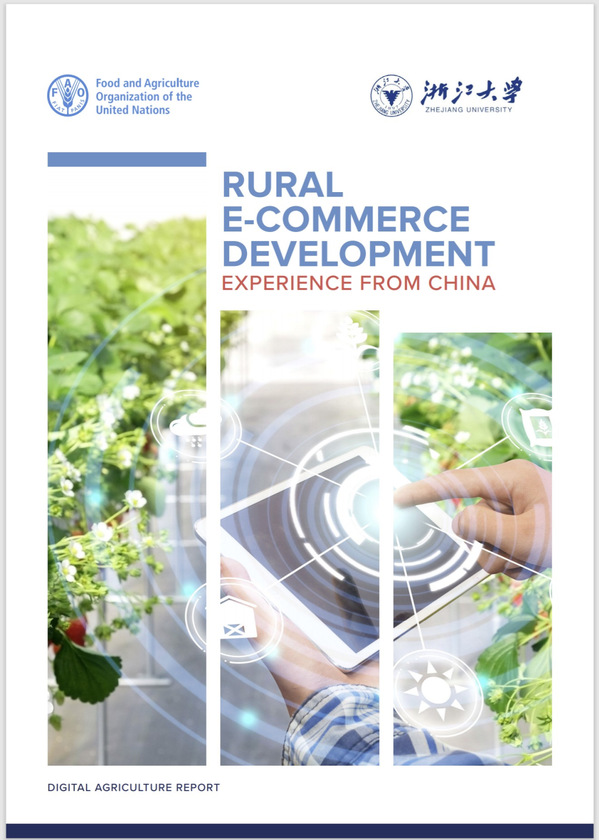[Editor’s Note: Recently, Food and Agriculture Organization of the United Nations (FAO) and Zhejiang University co-published the Digital Agriculture Report: Rural E-commerce Development Experience from China, exploring the role of rural e-commerce in transforming the agri-food systems in China. Just as Mr. QU Dongyu, the FAO Director-General, wrote in the Foreword, the report “marks a step on the pathway towards the FAO-led International Platform for Digital Food and Agriculture, the 1000 Digital Villages Initiative; and advocates for stronger South-South and Triangular Cooperation”. In this issue of Insight@ZJU, Prof. WEI Longbao, head of the ZJU’s team, shares the main points of the new book.]

Agri-food systems are the world’s largest economic sector in terms of employment, livelihoods and planetary impact. However, the agriculture and food sector is still facing huge challenges. According to the research of the United Nations, the global population is projected to reach over 9.6 billion in 2050. Natural resources such as fresh water and grassland is becoming increasingly deficient. The accelerated progress of urbanization may cause tremendous pressure on the protection of arable land. In addition, environmental deterioration and climate change will exacerbate the risks of agricultural natural disasters.
To better address the challenges and achieve the sustainable goals such as zero poverty and zero hunger, digital agriculture could be an effective way to transform the agri-food sector as a productive, inclusive and resilient ecosystem. Particularly, e-commerce, a new business model evolved with the development of modern information technologies, has made a great difference in driving consumption, employment, entrepreneurship and poverty alleviation in rural areas. As e-commerce has become a new engine of growth in multiple countries and regions, China plays a leading role, which accounts for more than 42 percent of global e-commerce transactions with an annual growth rate of 50 percent since 2011.
Aiming to explore the successful experience and best practice of rural e-commerce in China and summarize it into sharable and duplicable ideas and strategies, the Food and Agriculture Organization of the United Nations (FAO) and Zhejiang University jointly produced the Digital Agriculture Report: Rural E-commerce Development Experience from China. It is hoped that the value and benefits of rural e-commerce could be widely promoted and scaled up all over the world, especially in the developing countries.
Historical and current development of rural e-commerce in China
The development of rural e-commerce in China can be traced back to 2004, when the Ministry of Agriculture of China (now the Ministry of Agriculture and Rural Affairs) announced the “Rural Electronic Information” project to establish a cable network in rural areas. Since then, the rapid improvement of infrastructure has provided rural e-commerce with solid foundations. In 2019, more than 98 percent of China’s administrative villages are covered with optical fiber and 4G technologies. As of December 2020, about 55.9 percent of rural areas had access to the Internet in China.
By 2007, e-commerce platforms and enterprises had begun to spring up in China, and people in rural areas started to take advantage of e-commerce. The e-commerce could help to improve farmers’ income through introducing a new channel for farmers to sell their products and expanding their capability to access larger markets. On the other hand, e-commerce also offers farmers with more and better choices in terms of agricultural tools and production information. By 2016, the rural market had become the main battlefield for e-commerce platforms in China. In 2019, China’s rural online retail sales reached CNY1.7 trillion (USD262 billion), with a year-on-year growth of 19.1 percent.
As a benchmark of rural e-commerce in China, Taobao villages stand for those where more than 10 percent of local households operate active online stores or more than CNY10 million (USD1.5 million) revenue is generated from annual e-commerce transactions. In the past decade, the numbers and scale of Taobao Villages have experienced a sharp increase, growing from just 3 in 2009 to 5425 villages in 2020.
Impact of rural e-commerce
Rural e-commerce will transform not only the agri-food supply chain, but also the economy, lifestyle, entrepreneurship and ultimately the way that the rural sector looks.
In terms of economic impact, rural e-commerce could help farmers to raise production efficiency and lower costs, since they could obtain more access to real-time market information which will facilitate their decision-making in what to produce and how much to produce. Second, rural e-commerce could activate entrepreneurship and create employment. For example, a range of online tools and services are provided by various e-commerce platforms to help rural entrepreneurs to acquire online operating skills. Third, by overcoming the geographical limitations of the tangible market and reducing information asymmetry, rural e-commerce could expand the sales of agricultural products, foster market exchange and increase farmers’ income. In addition, rural e-commerce is also a strong driver of poverty alleviation and cultivation of rural talents.
Rural e-commerce could also deliver multiple social benefits. First, rural e-commerce could contribute to building livable new villages and achieve rural revitalization in terms of modern living facilities, improved ecological environment, better health and education services, and more youth staying in or returning to the rural areas. Second, rural e-commerce has brought new ideas to shape, promote and renovate traditional rural cultures. Third, rural governance could be transformed and enhanced with more talents, tools and awareness of digitalization brought by rural e-commerce.
With respect to environmental impact, e-commerce can improve the environmental sustainability in rural areas, due to savings in transport compared with traditional in-store shopping, and less water loss and land waste as a result of better production forecasts based on consumer demand.
Challenges encountered and proposals for the way forward
Although e-commerce could generate comprehensive benefits and positive impacts, the growth of rural e-commerce is still facing nonnegligible challenges. Most rural areas lack developed infrastructures, in terms of stable electricity supply, efficient logistics and full Internet coverage. Another issue comes to the poor literacy level of farmers, the limited access to advanced information, and the inadequate education opportunities in rural areas. It is also challenging that rural e-commerce may intensify the inequality for marginalized groups like smallholder farmers, women and youth, due to the huge requirement of initial investment.
To better overcome the challenges and realize the full potential of e-commerce, cooperation among multiple stakeholders, including the government, private sector and farmers, are required. The government takes a leading role in setting up policies and strategies to provide guidance and create an enabling ecosystem for rural e-commerce. The private enterprises can help to establish critical infrastructures for e-commerce, such as digital payment methods and logistics network. Last but not least, the improvement of farmers’ awareness and skills in digital technologies and innovative business models is of great importance as well.
Please click to download the ![]() full version of the book.
full version of the book.


